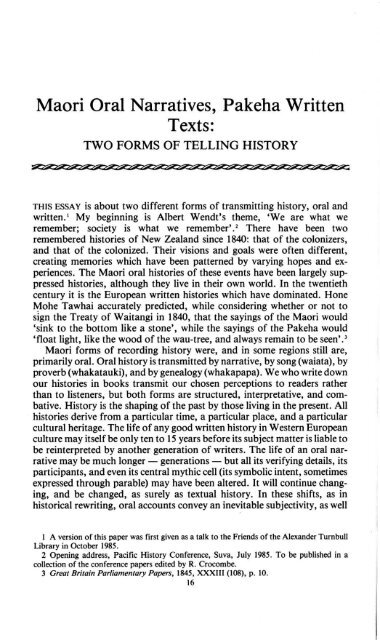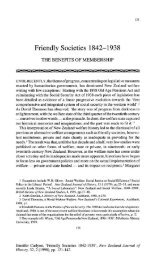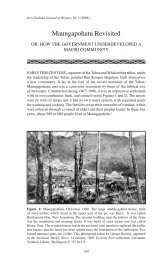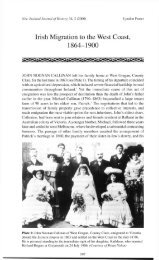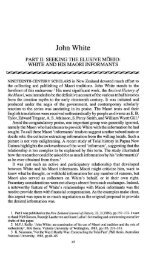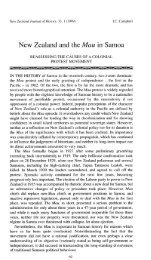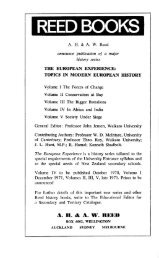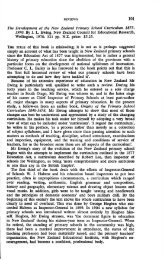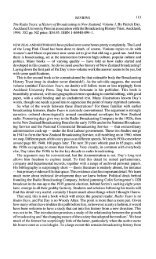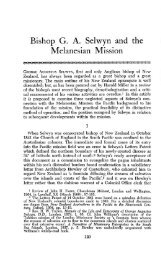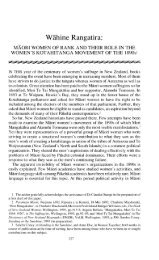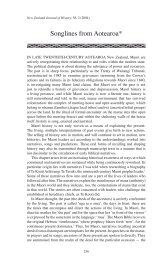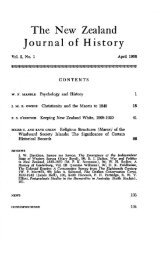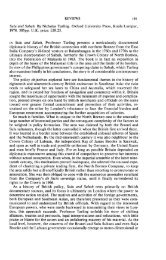Maori Oral Narratives, Pakeha Written Texts: - New Zealand Journal ...
Maori Oral Narratives, Pakeha Written Texts: - New Zealand Journal ...
Maori Oral Narratives, Pakeha Written Texts: - New Zealand Journal ...
Create successful ePaper yourself
Turn your PDF publications into a flip-book with our unique Google optimized e-Paper software.
<strong>Maori</strong> <strong>Oral</strong> <strong>Narratives</strong>, <strong>Pakeha</strong> <strong>Written</strong><br />
<strong>Texts</strong>:<br />
TWO FORMS OF TELLING HISTORY<br />
THIS ESSAY is about two different forms of transmitting history, oral and<br />
written. 1 My beginning is Albert Wendt's theme, 'We are what we<br />
remember; society is what we remember'. 2 There have been two<br />
remembered histories of <strong>New</strong> <strong>Zealand</strong> since 1840: that of the colonizers,<br />
and that of the colonized. Their visions and goals were often different,<br />
creating memories which have been patterned by varying hopes and experiences.<br />
The <strong>Maori</strong> oral histories of these events have been largely suppressed<br />
histories, although they live in their own world. In the twentieth<br />
century it is the European written histories which have dominated. Hone<br />
Mohe Tawhai accurately predicted, while considering whether or not to<br />
sign the Treaty of Waitangi in 1840, that the sayings of the <strong>Maori</strong> would<br />
'sink to the bottom like a stone', while the sayings of the <strong>Pakeha</strong> would<br />
'float light, like the wood of the wau-tree, and always remain to be seen'. 3<br />
<strong>Maori</strong> forms of recording history were, and in some regions still are,<br />
primarily oral. <strong>Oral</strong> history is transmitted by narrative, by song (waiata), by<br />
proverb (whakatauki), and by genealogy (whakapapa). We who write down<br />
our histories in books transmit our chosen perceptions to readers rather<br />
than to listeners, but both forms are structured, interpretative, and combative.<br />
History is the shaping of the past by those living in the present. All<br />
histories derive from a particular time, a particular place, and a particular<br />
cultural heritage. The life of any good written history in Western European<br />
culture may itself be only ten to 15 years before its subject matter is liable to<br />
be reinterpreted by another generation of writers. The life of an oral narrative<br />
may be much longer — generations — but all its verifying details, its<br />
participants, and even its central mythic cell (its symbolic intent, sometimes<br />
expressed through parable) may have been altered. It will continue changing,<br />
and be changed, as surely as textual history. In these shifts, as in<br />
historical rewriting, oral accounts convey an inevitable subjectivity, as well<br />
1 A version of this paper was first given as a talk to the Friends of the Alexander Turnbull<br />
Library in October 1985.<br />
2 Opening address, Pacific History Conference, Suva, July 1985. To be published in a<br />
collection of the conference papers edited by R. Crocombe.<br />
3 Great Britain Parliamentary Papers, 1845, XXXIII (108), p. 10.<br />
16
MAORI ORAL NARRATIVES, PAKEHA WRITTEN TEXTS 17<br />
as a new objectivity, which enables people to see the past, and the present,<br />
afresh.<br />
People living in an oral tradition often come from the past into the present<br />
when they explain the present. The pivotal place where this is done in<br />
<strong>Maori</strong> society is the marae and its meeting-house. In the korero spoken on<br />
the marae and within the walls of the house, history is shaped. There is,<br />
then, a continuous dialectic between the past and the present, as the past is<br />
reordered and the present reinterpreted. The cycle of traditions about the<br />
people, land and events is dynamic, not static. For the <strong>Maori</strong>, the past is<br />
seen as that which lies before one, 'nga ra o mua', the days in front. It is the<br />
wisdom and the experience of the ancestors which they are confronting and<br />
seeking to interpret. The words of the ancestors exist still in memory,<br />
wrought into oral tradition, and they themselves can be encountered as they<br />
appear to the living in dreams. 'Nga kupu a nga tipuna' or 'nga kupu tuku<br />
iho', the words and phrases of the ancestors, take on new meanings in new<br />
contexts.<br />
In listening to the voices of the colonized, rather than the observations<br />
and reports of those who were the colonizers, a gap in perceptions soon<br />
becomes apparent. As Gillian Chaplin and I talked about Rua Kenana and,<br />
subsequently, Te Kooti Arikirangi we came to understand this with ever<br />
greater awareness. 4 The focus of attention is different; the sympathetic<br />
identifications are different; the encrustation of meaning around events is<br />
different. What for the Prime Minister in 1908, Sir Joseph Ward, was a<br />
minor, tricky political negotiation with a troublesome leader of Tuhoe, was.<br />
for Rua a 'Ceremony of Union' between himself and the Crown, a ritual<br />
which had been formally enacted and had, therefore, fundamental obligations<br />
for both parties. The final assessment, or what it all meant, was inevitably<br />
different.<br />
It is only relatively recently that Western-trained historians have come to<br />
realize that they have been perpetuating colonialist attitudes in their socalled<br />
objective histories. At the same time, these histories have served, to a<br />
considerable extent, to erase <strong>Maori</strong> memories and perceptions. As the<br />
great-granddaughter of the nineteenth-century prophet Te Kooti said about<br />
her ancestor:<br />
I didn't know anything about him. I used to hear how he was a rebel and all that, and<br />
I didn't think I was connected to him. Because we weren't encouraged to talk about<br />
Te Kooti and whatever he did, if he was a good man or bad man. We weren't. This<br />
was at home. I was in Standard VI [in 1928], and we were asked to write about Te<br />
Kooti and, well, I didn't know. I didn't know anything about him. I went home and<br />
talked about it, and was told to forget it. 'Don't worry about it! It is over! Finished.'<br />
I went back and told them [my parents] that my headmaster was threatening to strap<br />
me. Because I didn't know anything about Te Kooti. And I asked them — then. My<br />
4 See the introductions to Judith Binney, Gillian Chaplin, Craig Wallace, Mihaia: The<br />
Prophet Rua Kenana and his Community at Maungapohatu, Wellington and Auckland, 1979,<br />
and Judith Binney, Gillian Chaplin, Nga Morehu: The Survivors, Auckland, 1986.
18 JUDITH BINNEY<br />
mother said, 'Oh well, it is too late now'. And she started telling me who we were,<br />
who he was. My grandfather was there and she said, 'That is his son sitting over<br />
there.' I must have been about fifteen then.'<br />
Her family history was suppressed because of shame. The overriding interpretation<br />
taught in Poverty Bay about her great-grandfather was, as she<br />
said, that he was an 'arch-rebel'. 6<br />
But quite other traditions had survived in the oral narratives and the<br />
waiata of Te Kooti. They convey quite different perspectives; other ways of<br />
seeing. They are, among the Ringatu, who are the followers of Te Kooti,<br />
the main means of conveying their history. These oral traditions coexisted<br />
alongside the written accounts of the victors. It is they which carry the<br />
Ringatu understandings.<br />
In the oral narrative forms what have survived are not so much directly<br />
political stories (although these do exist, particularly among men) but family<br />
myth-narratives. These are the histories which establish the particular relationship<br />
between Te Kooti and the family's own ancestors. <strong>Maori</strong> history is<br />
structured around kin. Whanau (the extended family) and hapu (the functioning<br />
tribal unit) are the basic concerns of <strong>Maori</strong> history. It is the whanau<br />
which gives identity to the individual, and the tipuna, the ancestors, are the<br />
source, in turn, of its mana. History is told in these terms. It is defined by<br />
family and by whakapapa. It is concerned with the holding and the<br />
transference of mana by successive generations.<br />
To attempt to cross the frontiers of European history and to gather oral<br />
narrative histories requires, therefore, an understanding that the narratives<br />
will be structured for their own purposes. The people with whom I have<br />
talked in recent years are those who have grown up within the Ringatu<br />
tradition. This means that they have most commonly been brought up by<br />
their grandparents (or other close kin), who had lived with Te Kooti. 'These<br />
old people' had perhaps been prisoners with him on Wharekauri, one of the<br />
Chatham Islands, between 1866 and 1868, or had ridden to him to learn<br />
about the new faith when he was sheltering with Ngati Maniapoto in the<br />
King Country between 1872 and 1883. It is these tipuna who link the living<br />
individual into the myth-histories which surround Te Kooti.<br />
5 Conversation with Hei Ariki Algie, Manutuke, 26 November 1983. It will be noticed that<br />
this quotation (and others which follow) differ slightly from the versions cited in either Nga<br />
Morehu or in Mihaia. In Nga Morehu, in particular, the narrative thrust was maintained in the<br />
transcription and editing of several interviews from different occasions; the quotation here is<br />
from the original transcript. One of the problems of transmitting oral accounts in written form<br />
are the decisions which have to be taken about removing repetitions, false starts, and diversions,<br />
which, if all were retained or indicated, would leave the accounts prolix, discursive and<br />
punctuated with multiple deletion marks.<br />
6 See for example W. Hugh Ross, Te Kooti Rikirangi: General and Prophet, Auckland,<br />
1966, p. 1. To an extent this view of Te Kooti is revived in Maurice Shadbolt's recent novel<br />
Season of the Jew, London and Auckland, 1986. At the same time, Shadbolt portrays a deeply<br />
critical view of many of the colonists and the militia leadership at Poverty Bay, and of the corrupting<br />
influence of the pursuit of vengeance by both <strong>Pakeha</strong> and <strong>Maori</strong>.
MAORI ORAL NARRATIVES, PAKEHA WRITTEN TEXTS 19<br />
I can tell my own story about my great-grandmother, because she was a follower of<br />
Te Kooti. Well, I come from the Bay of Plenty. That's how I know — my greatgrandmother<br />
— she was a staunch follower of Te Kooti. When she was a young<br />
woman, they transported her with all the other <strong>Maori</strong>s around Gisborne to Chatham<br />
Islands. Whakarau they call them. My great grandmother was one of the whakaraus<br />
[the captives], I remember her saying to me when I was a girl, oh, they were driven<br />
from Opotiki on the buggies to Poverty Bay, all the Ringatus in those days. Oh, it<br />
was sad. They were taken to the wharf, and Captain Porter' was with the soldiers in<br />
those days, the red coats she calls them, 'nga hoia koti wherowhero — koti toto' —<br />
eh?' And she calls, 'Captain, captain!' 'Hurry up, hurry up! Go on the boat. Go on<br />
the boat!' And Te Kooti called out to that fellow, Porter, 'When I come back (in<br />
<strong>Maori</strong>), when I come back I will slay you!' Which he did, when he did come back.<br />
. . . They were there for about two years. Then she came back .... She was with<br />
him too, for a little while, at Te Kuiti [living in exile]. Then when her first husband<br />
died she went back to Torere. She brought us all up; four generations she brought<br />
up.<br />
She was a makutu old lady, and I didn't realize it until I grew up and they told me<br />
that my great-grandmother had some mana. Some power. She could destroy, you<br />
know. You did something wrong against her, she just prayed. Some kind of prayer<br />
that she uses, and it reacts on to that person. . . . That mana was given to her by Te<br />
Kooti. Te Kooti bestowed it upon her.'<br />
This woman's focus here is that her own knowledge, and her right to<br />
speak, derives from her great-grandmother. Her account conveys an alternative<br />
history, the perspectives of the whakarau. It opens up other worlds<br />
of causation.<br />
In a similar manner, her husband recounted the narrative of his grandfather,<br />
Te Hira Uetuku, and Te Kooti.<br />
My grandfather, he went there [Te Kuiti], in 1878. There was a lot of confusion with<br />
this land, Mangatu. So they said over here, 'Go and see Te Kooti'. So he went to see<br />
Te Koot', and when he got there — Te Kooti had a habit of misleading people to test<br />
you at all times to see how good your faith is. Well, he was going there and tell Te<br />
Kooti, 'Oh, what's going to happen to this land that belongs — that my greatgrandfather<br />
has fought for? What's going to happen to it?' In other words, he's<br />
going there for his family in preserving and maintaining his rights to the land. So Te<br />
Kooti said to him, 'Well, now that you're here, I see you people are very tired —<br />
here's a bottle of whisky.' And my grandfather — well, his friends all got that bottle<br />
of whisky, all had a drink, but my grandfather refused. My grandfather said, 'No. I<br />
came for a purpose and my mission is about the land. Mangatu.' Then, I think he put<br />
a curse on the ones that already had a drink of that bottle —<br />
Heni: That's my family! My people! They're all dead now!<br />
Ned: Te Kooti said, 'Oh well, I'll give you something — he mauri. He mauri mo<br />
te whenua.' Pertaining to some powers unknown to us. That he will preserve your<br />
7 There is a confusion in this narrative between Captain Thomas Porter and Captain<br />
Reginald Biggs, both of whom were instrumental in having Te Kooti sent into exile. Te Kooti<br />
subsequently killed Biggs in reprisal.<br />
8 'the soldiers with the red coats — bloody coats'.<br />
9 Conversation with Heni Brown, Whatatutu, 14 February 1982.
20 JUDITH BINNEY<br />
rights to the land. So my grandfather never talk about this thing. But I hear a lot of<br />
others — outsiders — talking about it. 'Cos it is believed that it was part of the diamond<br />
that Te Kooti used — to go through the dense bush at Te Wera. And those that<br />
followed him saw it. It was in the form of a lamb: the diamond. Some say that it is a<br />
portion, or part of it, broken off from that, and given to my grandfather to bring<br />
back and plant it on Mt Maungahaumi[a]. That is the mauri, to hold and preserve<br />
the family in the years to come. It was told to Te Hira's father, old Pera Uetuku<br />
Tamanui. Te Kooti said to him, 'You can sell the rest of Mangatu, but don't ever sell<br />
the mountain. Hold the mountain. Because that mountain in days to come, well,<br />
your great-great-grandchildren will have a footing. It's better that than having no<br />
land.' So, Te Hira said to Te Kooti, 'Well, you can see my horse is used up. It's been<br />
a long ride from Mangatu to here, to Te Kuiti.' — Te Kuiti, by the way, is named to<br />
decipher things — for 'hei kuiti nga tikanga o te iwi <strong>Maori</strong>' — if any problems between<br />
the <strong>Maori</strong> people, well, Te Kuiti was the place for it. Hei kuiti nga tikanga o te<br />
iwi <strong>Maori</strong>. We have parliament members to decide things for the people, for the running<br />
of the country. Te Kuiti was named on that principle for the <strong>Maori</strong> people. —<br />
So my grandfather said to him, 'Oh, you can see my horse is used up. He'll never do<br />
this trip.' So Te Kooti said to him, 'Well, you've got a mission and it's got to be<br />
fulfilled. Take my horse.' I believe my grandfather was the only one, apart from Te<br />
Kooti, rode that horse. The white horse. It took him only a day to come from Te<br />
Kuiti to Maungahaumia and back again, to fulfil his mission. 10<br />
This narrative establishes this family's relationship both to the prophet<br />
and to their land. It shows the <strong>Maori</strong> practice whereby history was, and still<br />
is among the Ringatu, conceived as an extension of mythology. Many of the<br />
narratives about Te Kooti endow him with super-human powers, which are<br />
believed to have been given to him by God. In this story Te Kooti tested Te<br />
Hira and, when he had proved himself, gave him the mauri, the diamond,<br />
to protect the tribal mountain. Te Kooti thus bestowed upon this family's<br />
tipuna his protection, and a portion of the diamond which is, in this narrative,<br />
identified with the sacrificial Lamb of God. The diamond therefore<br />
carries a multitude of meanings. It is not only an image of hidden wealth, or<br />
power to be recovered in 'the days to come'. It recreates the quintessential<br />
image for the <strong>Maori</strong> world, Te Ao Marama, the world of light and<br />
knowledge, and it specifically asserts through its biblical reference the<br />
salvation of the people in the 'days to come'.<br />
The ancestors share in these divinely-bestowed powers. The narratives<br />
tell of their mana, and also convey a predictive view of history which<br />
assures that the people's autonomy will be restored, as the wheel turns, and<br />
the past is renewed in the present.<br />
The actual form of the narratives is like a fan. At the apex is the core<br />
narrative, which estabishes the whanau's link to the prophet-leader, his<br />
teachings, and his particular words for them. From this apex flows the<br />
history of the family, through two or three generations to the living. Some<br />
of the family histories are similar and, indeed, they may share a 'core' nar-<br />
10 Conversation with Ned and Heni Brown, Whatatutu, 14 February 1982.
MAORI ORAL NARRATIVES, PAKEHA WRITTEN TEXTS 21<br />
rative. But the ancestors about whom the history is told are always their<br />
own.<br />
Genealogy is the backbone of all <strong>Maori</strong> history. Critical narratives may<br />
therefore be rearranged, in both time and place, around the appropriate<br />
ancestors. <strong>Maori</strong> oral narrative history is obviously concerned with its own<br />
leaders. They may not necessarily be those who have been particularly<br />
noticed in the European world. There will also be conflicts between narratives,<br />
as whakapapa and kin order their priorities and their truths. <strong>Maori</strong><br />
history is agonistic, and old conflicts will be refought in words, as anyone<br />
who listens to whaikorero on the marae will know. It is, therefore, extremely<br />
difficult simply to insert an oral tradition into a written text which purports<br />
to deal with the same events.<br />
For example, one of the favourite devices in all oral narrative traditions<br />
is the riddle. The riddle is a form of structuring, like the parable, that<br />
enables new meanings to be found in old stories. A riddle is a test for the<br />
listeners as well as for those in the story. In the story the task is usually set<br />
by those with access to knowledge which is ultra-human in its source. The<br />
answer will only be discovered by those with faith. Here is a riddle told concerning<br />
the successful escape of the whakarau from the Chatham Islands in<br />
1868. In this story, the Archangel Michael sets a task for the prisoners:<br />
And before, Te Kooti referred to this Angel, Michael, coming to rescue them. He<br />
said to them, 'Look, here's a stone! I want you people to eat it. If your faith is good,<br />
you can do it.' So I believe old Penehau put it in his throat — almost choke —<br />
couldn't get it down — too big! So, they had a session with one another. 'How we'<br />
going to eat that stone?' Just saw old Pene trying to perform, how to swallow it — it<br />
won't work! So, all right: 'Let's all put it to God. Tell God to help us.' And when<br />
they went to sleep it was given to one of them in a dream. He woke up startled, and<br />
he said, 'I've got it! I've got it! I've got it!' And they all woke up and said, 'What?'<br />
'Oh, how to eat that stone.' And he got that stone and pounded it into dust. Got it all<br />
into dust and he gave you a bit. That's how we were told.<br />
Heni: That's the sharing. That's right. 'Cos my great-grandmother ate that stone.<br />
Ned: 'Cause Te Kooti said, 'You people got to swallow that stone.' But they<br />
couldn't find an answer. But in a dream, after their prayers, the Lord blessed them.<br />
This particular person was given the understanding. Everyone of them had a bit. So<br />
they were rescued [from Wharekauri]. 11<br />
In this manner, the understanding of the mystery, the solving of the riddle,<br />
gave the prisoners their deliverance.<br />
The systems of explanation which are embedded in the narrative traditions<br />
create the mental world which the people inhabit. Their decisions and<br />
actions — their 'history' — are all influenced by their systems of belief. Rua<br />
Kenana's first wife, Pinepine Te Rika, became a tapu woman. She became<br />
tapu from about 1905, the time when she, according to the oral narrative<br />
traditions of the Iharaira, the followers of Rua, climbed the sacred moun-<br />
11 Conversation with Ned and Heni Brown, 14 February 1982.
22 JUDITH BINNEY<br />
tain of the Tuhoe, Maungapohatu. She later told people of her experiences<br />
on the mountain, and this narrative has become a part of the oral tradition<br />
of the next generation:<br />
Ana, ka moe au i te tama a Pinepine ia Te Whatu, ana, ka korero mai te mama ki au<br />
ana, i to raua pikinga ki Maungapohatu, te maunga. Penei noa te whanaui o te rori<br />
ne, he kohu hoki. E toru pea ana okiokinga ka eke raua ki runa i te papatahi i runa.<br />
Ka korero mai a Pinepine; i te mea naku ka korero mai ki ahau, kare e korero ki etehi<br />
. . . . Ko te mea ke ra hoki, ko te taimana. Koia ke ra hoki te piki a Tai raua ko<br />
Mami ki reira. Na ra e korero mai ana a Mami ki au, ana, na Te Atua tonu a Tai i<br />
tono kia haere ki reira, kia piki, mana e arahi, ana, ka kite ia i Te Karaiti raua ko tana<br />
tuahine i reira, i te maunga ra.<br />
Well, I married the son of Pinepine, Te Whatu, and his mother told me when they<br />
climbed Maungapohatu, the mountain. The road was only this wide, and foggy. She<br />
must have rested about three times before they reached the flat on the top. Pinepine<br />
said she would not relate this to any other person but me.... It was that thing, that<br />
diamond, that was the reason. That was the reason Tai [Rua] and Mami [Pinepine]<br />
climbed up there. Mami was telling me that it was God indeed who sent Tai to go<br />
there, to go to the top. He must take the lead. Then it was s/he saw Christ with his<br />
(Christ's) sister there, on that mountain. 12<br />
From this moment Pinepine was set apart. She could not cook food for<br />
herself, because cooked food violates the state of tapu, or the state of being<br />
under the influence of the gods. Te Puhi said Pinepine was, for a time,<br />
always carried outside" the pa for her meals, and her hands were always<br />
washed before leaving. She had to be fed with feeding sticks, or from her<br />
own ratao (platter of leaves) by Marumaru, her female companion.<br />
Pinepine was tapu because she had seen what Rua had seen: the hidden<br />
diamond. The diamond is, again, the mauri whenua, the guardian of the<br />
land and the people, the Tuhoe, and it is the symbol of their hidden mana.<br />
In some narratives it is said to have been placed there by Te Kooti; in others<br />
it has always been there. But it was Te Kooti who covered it with his shawl<br />
('horo'), or, alternatively, the tartan rug that is particularly associated with<br />
him. As a tapu woman, Pinepine also lived apart from her husband, unlike<br />
all Rua's other wives. Equally, she was seen as King Solomon's wife,<br />
Pharaoh's daughter, who lived apart in her own house. 13 Pinepine, then,<br />
lived in a world which was ordered by a framework of thought that was<br />
both <strong>Maori</strong> and scriptural in its origins, and which can be explained only by<br />
reference to the narrative of the vision on the mountain. Pinepine died in<br />
1954.<br />
Te Kooti created this body of thought, and the actions it has successively<br />
generated. He was not the only <strong>Maori</strong> leader to possess and transmit such a<br />
world view. All the major prophet leaders of the nineteenth and twentieth<br />
centuries have created histories which are predictive in the telling, and<br />
12 Conversation in <strong>Maori</strong> with Te Puhi Tatu, Maungapohatu, 22 January 1978. Transcription<br />
and translation by Rangi Motu.<br />
13 The scriptural text from which this identity was taken is I Kings 7:8.
MAORI ORAL NARRATIVES, PAKEHA WRITTEN TEXTS 23<br />
hermeneutic in their systems of resolution. For the Ringatu, however, it is<br />
Te Kooti who is critical and, indeed, he created a faith which has endured.<br />
The old Ringatu matakite (seer) and tohunga (reader of signs) Eria<br />
Raukura, who came from inland Poverty Bay, explained that it was on<br />
Wharekauri, where both he and Te Kooti were imprisoned from 1866 to<br />
1868, that the two traditions were joined in a revelation by the angel<br />
Michael to Te Kooti. The <strong>Maori</strong> lineage he stated as deriving from the<br />
spiritual encounter of the ancestors with Io, when they arrived at Aotearoa.<br />
These were 'the things of the past', 'nga mea a muri nei', which were joined<br />
with 'the first things', 'nga mea tuatahi', or the prophetic sayings from<br />
Abraham until Christ. 'Te hononga', Eria called it, 14 or the marriage of two<br />
predictive views of history, and of two perceptions of the present as a cyclic<br />
renewal of the past. All the Ringatu explanations of history derive from this<br />
conjunction of thought. They assert an overarching interpretation of events<br />
in a testimonial form of telling history: that is, where the predictive words<br />
of the prophet-leader, or 'nga kupu whakaari', are fulfilled in other, apparently<br />
discrete events. The events give testimony to the words. This<br />
predictive form of telling history is found particularly in oral societies, and<br />
it infused the Bible. As Walter Ong has commented, the orality of the<br />
'mindset' in the biblical texts is overwhelming."<br />
The oral narratives which surround Te Kooti are concerned with the<br />
future, restored, autonomy of the people in their land. They assert that Te<br />
Kooti's powers were derived from God, and they demonstrate how he<br />
shared his powers, his mana atua, with those who followed him. He gave<br />
them taonga — precious objects and precious knowledge. These powers are<br />
temporary, and are held only in trust. They can be used for good, or for ill;<br />
that is their burden. So 'history' constantly tests the leaders, and the people:<br />
and that is what the narratives are about. They assert the separate nature of<br />
the authority of the <strong>Maori</strong> leaders from that of colonizers. The <strong>Maori</strong> mana<br />
preceded the colonizers, and the narratives state that it is upheld by God,<br />
through his prophets.<br />
An account given by one of Rua's followers tells how the divinelybestowed<br />
power of Te Kooti was transferred to his successor. This mana<br />
was held for a while, in trust, with the chiefly leader and tohunga of<br />
Waimana, Te Whiu Maraki:<br />
Te Kooti had this thing of God. And he said to this old man, Kuku — Te Whiu —<br />
'I'll give you something to keep in your hand. Keep it for safe.' And Te Whiu says,<br />
'What is that?' 'Oh, the life of the whole of the Waimana people. Something to look<br />
after them.' Te Whiu says, 'All right. I'll have it.' So he gave that thing to Te Whiu.<br />
And when Rua came, trying to be God, when he came from Maungapohatu out to<br />
Waimana, well, the day they left Maungapohatu, he told a man to go and run ahead<br />
of him and get Te Whiu to give this thing that Te Kooti gave him. So this man rode<br />
14 Paora Delamere, Poutikanga of the Haahi Ringatu, Manuscript Notebook, n.d., private<br />
collection, pp. 34-35.<br />
15 <strong>Oral</strong>ity and Literacy, London and <strong>New</strong> York, 1982, p. 75.
24 JUDITH BINNEY<br />
down to Waimana, and he went to Te Whiu and asked him for that thing. Te Whiu<br />
said, 'No, he won't have it. I'm going to keep it for myself.' So this man rode back<br />
and met Rua at Tawhana, that night, and Rua says to him, 'Well, how you got on?'<br />
'Oh, he won't let you have it. That's his own keep.' 'Oh.' So — Rua says to this man,<br />
'Tomorrow morning, you ride out ahead of us in to Waimana and tell him to give<br />
you this.' So, next morning he went. The rest of the people came after. When they<br />
got to Matahi, they met there. Rua asked him, 'Well, what is it?' 'He won't give it to<br />
you. You're not the Son of God.' So Rua says, 'Oh well, I'll go in myself tonight.'<br />
And then, that very night, this old man told his daughters and his son, Te Maipi,<br />
'That thing has gone out of my hand. That's the man all right — coming. Rua.' So in<br />
the morning we all gather up to Tataiahape and wait for him. 'That's the man. This<br />
thing in my hand has gone. He's got it now.' In the morning, this man Rua used to<br />
send before him, he came up and was waiting for Rua to tell him what to do that<br />
morning. When Rua came, he said, 'It's all right. Let your horse go. I've been there<br />
last night. I got it in my hand.' So he had it. . . . That thing — he got it from Te<br />
Whiu. It's got a bit of a share for the people. That's my way of thinking."<br />
In the <strong>Maori</strong> oral histories the tribal or family heroes are unique, yet the<br />
stories may be similar. This similarity is evident in the discrete accounts of<br />
Te Hira Uetuku of Ngariki, the ancient hapu of Maungahaumia, and of<br />
Rua, whose mother (from whom he traced his descent) was from Tamakaimoana<br />
of Maungapohatu. At the heart of each narrative is the diamond;<br />
and at the heart of each is the protection Te Kooti bestows upon the people.<br />
But the tipuna are their own, and each narrative is a statement of their<br />
mana.<br />
You might ask further about Eria Raukura, as I once did of a Tuhoe<br />
elder. He replied angrily, 'Eria! What do you want to bring him in for?<br />
He's from Waimaha [on the other side of the Urewera ranges]. He'll<br />
makutu you!" 7 Eria, and the narratives which placed him as a matakite<br />
were local, and I was on the wrong side of the mountains. At Tataiahape in<br />
the Waimana valley, where I was, Eria was a threatening force because he<br />
had broken from Rua. Eria had been baptized by Te Kooti in 1881 as the<br />
leading tohunga to teach the faith, and was, therefore, a major figure in<br />
Ringatu history. He had originally endorsed Rua as Te Kooti's successor,<br />
and he died only in 1938. But despite being part-Tuhoe, he 'belongs' to the<br />
Gisborne side: so don't ask about him in the Bay of Plenty.<br />
Different histories, then different heroes. In the oral form of telling<br />
history, the narrative belongs to the narrator. This can be seen most clearly<br />
when the narrator tells the story as events in which he or she participated,<br />
but which occurred before the narrator was born. Paora Tuhaere, the nineteenth<br />
century Ngati Whatua chief, told Percy Smith: 'My home was<br />
Muriwhenua, it was my permanent residence because my ancestor lived<br />
there. Later I left Muriwhenua because of this murder [which he had<br />
described]. Then I tried to revenge myself and Hokianga's people were<br />
16 Conversation with Hillman Rua, Rotorua, 21 May 1978.<br />
17 Conversation with Horopapera Tatu, Tataiahape, 27 January 1978.
MAORI ORAL NARRATIVES, PAKEHA WRITTEN TEXTS 25<br />
defeated and I took possession of the old country [Hokianga]. Because of<br />
this battle the whole of Hokianga was finally taken by me. . . and I lived in<br />
the country because all the people had been killed." 8 All these events occurred<br />
long before Tuhaere was born.<br />
This form of narration was common in the accounts given orally in the<br />
<strong>Maori</strong> Land Court in the nineteenth century. While I have not encountered<br />
people describing and inhabiting a past before they were born, I have<br />
encountered the personal presence of the narrator in events in which they<br />
were not physically involved. The accidental shooting in 1925 of Henare,<br />
Rua's only son by his rangatira wife, Te Akakura Ru, when Henare was<br />
about 15 years old, shattered the whole community. It has been described to<br />
me by several people. Sometimes, they were the only person who witnessed<br />
the accident. The event has become a part of the life of the narrator. This is<br />
not merely dramatic emphasis, nor for the sake of telling a good story. It is<br />
what has been aridly called the 'kinship I'," and it reaches not only into the<br />
past but into the future as well: 'Thus it is that I am born in you'. To be a<br />
<strong>Maori</strong>, as the Ngati Rereahu elder Henare Tuwhangai observed in the 1985<br />
documentary programme on 'Te <strong>Maori</strong>', is to share the world with the<br />
tipuna and the whanau. Consequently, history is told in these terms.<br />
The oral histories will cluster around the immediate ancestors of the living<br />
whanau. Most of the ancestral stories recorded by Elsdon Best from<br />
Tuhoe at the beginning of this century have now passed out of local tradition.<br />
20 The focus of the whanau ancestors has moved down the<br />
whakapapa. Thus the old stories drop out, or are reworked around the different<br />
ancestors. The whanau is effectively the two or three generations<br />
back from the present family: a time span that most people can recall. A<br />
few of the narratives will, however, pass into the wider 'oral tradition'.<br />
They will, in turn, evolve. Thus the story of Rua and Pinepine on<br />
Maungapohatu has passed into Tuhoe oral tradition and is known among<br />
all Iharaira families. But when Te Puhi narrated it, she still emphasized that<br />
she knew the history only because Pinepine, her mother-in-law, had told<br />
her. Her identification of her source, Pinepine, was her means of stating the<br />
veracity of the narrative. Other versions, also stated as deriving from<br />
Pinepine, have already developed significant differences. Whaitiri, the early<br />
Tuhoe ancestress and deity of lightning, is present in Heta Rua's version of<br />
this narrative, 21 as well as in Te Puhi's. But it is only in Te Puhi's account<br />
that Christ is also present with his 'sister' ('tuahine'), Whaitiri, on the<br />
mountain top.<br />
18 Cited J. Prytz Johansen, The <strong>Maori</strong> and his Religion in its Non-Ritualistic Aspects,<br />
Copenhagen, 1954, p. 36.<br />
19 ibid.<br />
20 Jeffrey Sissons, 'Te Mana o Te Waimana. Tuhoe History of the Tauranga Valley', Ph.D.<br />
thesis, University of Auckland, 1984, p. 165.<br />
21 Told on two occasions, 18 May 1978 and 23 May 1982, and cited in Judith Binney, 'Myth<br />
and Explanation in the Ringatu Tradition', The <strong>Journal</strong> of the Polynesian Society, 93,4 (1984),<br />
pp. 359-60.
26 JUDITH BINNEY<br />
That oral narrative histories are not the prerogative of the men and the<br />
formal oratorical domain is already evident. In <strong>Maori</strong> society, women are<br />
important purveyors of family history and its values. The inner strength of<br />
the whanau derives from the women. As Heni Sunderland of the<br />
Rongowhakaata people commented, 'Without a doubt, it is the women<br />
who have the strengths. Within the extended family and out onto the marae<br />
as a whanau as a whole, you will find it is we, the women, who are the ones<br />
who really motivate our men. They wouldn't like me saying that, but I do<br />
think that.' 22 The women are also usually the composers of the oriori, the<br />
lullabies written for children by which they are taught the history of the<br />
whanau and the hapu. It is the women, therefore, who are the first conveyors<br />
of history.<br />
For them, the experience of childlessness, or wharengaro — the house<br />
destroyed — is to be most feared. A high post-neonatal infant mortality has<br />
occurred with a remorseless frequency among <strong>Maori</strong> families for much of<br />
this century. Its occurrence is often attributed to a fault, and it may also be<br />
seen as having been predicted for the family. Ancestral history will be<br />
searched for an explanation. The solution, it follows, must be sought in<br />
faith and ritual. As one woman explained:<br />
My first one was what you call a premature. Just lived a week. I was riding horses and<br />
that, not knowing how it goes. What to expect. The first one is hard. ... I had<br />
John, my second one, right on here, right on this corner [of the meeting-house]. . . .<br />
He was seven months old when he died — at Maungapohatu. Then the old people<br />
had to go around, saying something about it, eh, losing your kids. Quite a few of us,<br />
as they said. That's the wharengaro, losing your child. It goes in the family. A<br />
wharengaro is a family that doesn't conceive. What child they have, it dies.<br />
So my family all got together. And that's why I got my third one. Old Tuhua, he<br />
was the eldest on my mother's side, in that family. He's the eldest of the Pari family<br />
— the Te Rika's. There was another family that had lost about, how many? — four,<br />
five kids. That's why I said it comes in our Te Rika family. It was all done in the one<br />
time, same time. These two families got together at the same time. Got all to agree to<br />
one thing. You have got to be all of one mind, not one pulling one way, one pulling<br />
the other. Tuhua came down, and they asked him. It was 1944. Each one had to get<br />
an offering, a koha, for their own family. He looked through the line of the family.<br />
It's always there; it's like a curse. And once you understand, then you get kids. 23<br />
In this very personal account (here abridged), the interpretation and the<br />
human actions are derived from a larger frame of understanding which is<br />
essentially <strong>Maori</strong>. It rests on the perceived conjunction between the past<br />
and the present, and between the ancestors and the living.<br />
The oral, myth-narrative tradition, encrusting meaning around events,<br />
has clearly survived to the present day. It has survived most particularly<br />
among people who were brought up in the small rural communities, which<br />
retained their own cultural and religious identity for much of this century.<br />
22 Gisborne, 11 May 1984.<br />
23 Conversation with Miria Rua, Tuapo, 7 May 1984.
MAORI ORAL NARRATIVES, PAKEHA WRITTEN TEXTS 27<br />
But it has also survived in other environments. The Maramatanga tradition<br />
within the Roman Catholic church, developed in the 1920s and 1930s and<br />
revived again in the 1960s, also retains systems of historical explanation<br />
which stem from a cosmology where the spirits of the dead, the wairua, are<br />
considered to be the media of communication between God and man.<br />
These ancestral spirits explain and direct 'history' for the living. 24 The<br />
Maramatanga faith is centred in Levin, north-east of Wellington. Its<br />
followers are active in <strong>Maori</strong> affairs at a national level. They 'are not<br />
marginal individuals, alienated from the mainstream of <strong>Maori</strong> society.<br />
Their ready access to all important currents, their central and pivotal positions<br />
cannot be ignored.' 25 They are considered important within the<br />
Kingitanga, and within the Ratana movement. Their iconography and their<br />
religious beliefs form a system whereby they manage to keep the <strong>Pakeha</strong><br />
domination at bay.<br />
This brings me back to the central problem for a Western historian.<br />
First, <strong>Maori</strong> oral history is not merely another source of information, nor<br />
even of perception. The purposes of the oral narrative tradition are to<br />
establish meaning for events, and to give a validation for the family's and<br />
the group's particular claims to mana and knowledge. Some pivotal family<br />
histories may develop as the hapu's structured histories. They will be told,<br />
for a purpose, on the marae. An awareness of the structuring of the oral<br />
narratives also makes one very aware of the responsibilities engendered in<br />
recording oral history.<br />
The primary responsibility must be to those with whom you have talked.<br />
It is their history. In the areas in which I have worked, individuals and<br />
families have allowed me to record some of it, because they share my view<br />
that recording is important. <strong>Maori</strong> history can then be communicated to<br />
<strong>Maori</strong> who no longer have access to it. I write here with an awareness of the<br />
positive responses among the Tuhoe and other <strong>Maori</strong> to a written history,<br />
based to a considerable extent on oral accounts, of Rua. 26 Secondly, the<br />
transmitting of <strong>Maori</strong> perceptions allows the colonizers to see the perspectives<br />
of the colonized — a necessary step so that the dominant culture<br />
changes its attitudes about its possession of 'truth'.<br />
The integrity of the various oral histories has to be retained when they<br />
are transmitted in a written form. These accounts are focussed quite differently<br />
from the linear history, or diachronic order, of the European<br />
historical tradition. Anthropologists have mostly tried to maintain the integrity<br />
of such world views by a synchronic approach. For the historian this<br />
is an inadequate approach, as it is for the anthropologist wrestling with the<br />
problems of cultural transformation. The contradictions in what constitutes<br />
history — oral and written — cannot be resolved. We cannot<br />
24 Karen Sinclair, 'Maramatanga: Ideology and Social Process among the <strong>Maori</strong> of <strong>New</strong><br />
<strong>Zealand</strong>', Ph.D. thesis, Brown University, 1976, p. 215.<br />
25 ibid., p. 166.<br />
26 Mihaia, 1979, 2nd ed„ 1987.
28 JUDITH BINNEY<br />
translate other histories into our own. We can merely juxtapose them. 27<br />
The structures and the events have been bonded, culturally, in time and<br />
place. We need to remember, too, that the European forms of writing<br />
history can be considered to be just as subjective in their criteria of what is<br />
important and what is relevant as the oral forms.<br />
<strong>Maori</strong> oral narrative histories convey what is seen to be the essence of<br />
human experience to the people who are living. As the Samoan historian<br />
Malama Maleisea has commented, if there were a truth, there would be no<br />
histories. 28 Or equally, as the Nigerian writer Chinua Achebe put it, in his<br />
evocative novel about the colonization of his country, Things Fall Apart,<br />
'There is no story that is not true .... The world has no end, and what is<br />
good among one people is an abomination with others.' 29 He was writing of<br />
the coming of the whites to the Igbo of Nigeria.<br />
To incorporate <strong>Maori</strong> oral traditions into written history, then, is not a<br />
task to be undertaken easily. Yet there is currently much demand for<br />
'<strong>Maori</strong>' history from the community. If it is to be undertaken it must be<br />
with the awareness that its concerns are probably different. The primary<br />
structuring of the recent <strong>Maori</strong> oral history is family history. But if family<br />
and genealogy, whanau and whakapapa, order <strong>Maori</strong> history, so notions of<br />
causation and consequence — which transform chronicle into explanatory<br />
history — are equally cultural. In the Ringatu <strong>Maori</strong> world, they are derived<br />
from a very ancient cosmological framework, one where divine forces intervene<br />
in this world. Witi Ihimaera's recent novel The Matriarch evokes<br />
this powerful conjunction of myth with history. 30 Such a view is not unique<br />
to the Ringatu. The lineage of prophetic tradition and the acceptance of the<br />
power of matakite infuses all the major <strong>Maori</strong> movements, religious and<br />
political. The old cosmogonic traditions have been interwoven with the<br />
biblical hermeneutic traditions of telling history by a succession of <strong>Maori</strong><br />
prophet-leaders in the nineteenth and twentieth centuries, of whom Te<br />
Kooti was only one of the more important. Today, all <strong>Maori</strong> movements<br />
trace their descent from this lineage of the prophets. The ideology which<br />
these narratives convey offers solutions to the problems that <strong>Maori</strong>s still<br />
face in their own land. The 'telling of history', whether it be oral or written,<br />
is not and never has been neutral. It is always the reflection of the priorities<br />
of the narrators and their perceptions of their world.<br />
University of<br />
Auckland<br />
JUDITH BINNEY<br />
27 Sissons comments intelligently on these dilemmas in his Tuhoe history, pp. 169, 418.<br />
28 Pacific Studies Conference, Auckland University, August 1985.<br />
29 London, 1984, p. 99.<br />
30 Auckland, 1986.


